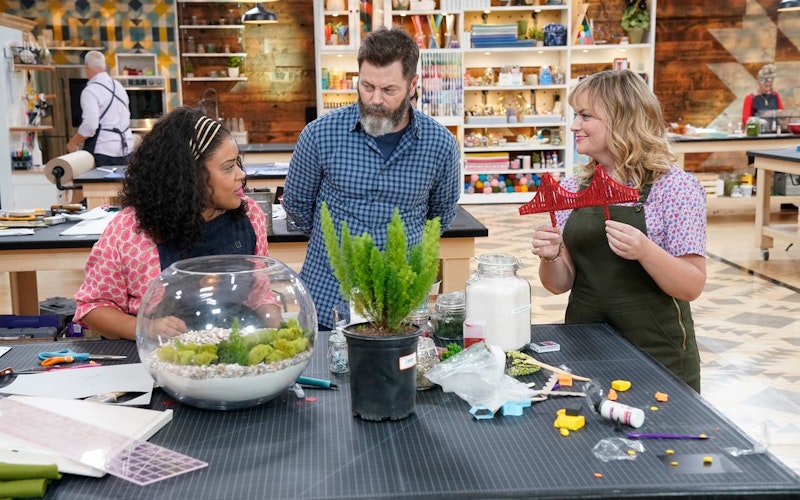
TV
Celebrating ‘Sub-Creators’ on Making It
Making It is a new competition show hosted by Parks and Recreation alums Amy Poehler and Nick Offerman. The two stars gather a field of crafters and give them the chance to demonstrate their skills by making crafts around a common theme. The whole thing feels like a fairy tale, almost too good to be true: a low-stakes reality-television competition with minimal drama or tears. Perhaps that’s why the show also brings to mind J.R.R.Tolkien’s essay “On Fairy Stories,” which sees human creativity and imagination as distinctly spiritual.
“On Fairy Stories” lays out Tolkien’s concept of humans as “sub-creators,” people who use the magic of their imaginations to create their own secondary worlds from the building blocks of our own. In doing so, he suggests, we step back, take a reprieve from the world, and reset our perceptions of reality. Tolkien writes about sub-creation as a method to aid recovery—recovery from boredom, from weariness of the world, from being overwhelmed by its complexity and darkness. Tolkien’s essay is concerned with writing fantasy stories, but he uses other forms of artwork to illustrate his point.
Making It is one such method of escape. The show is clearly modeled on The Great British Baking Show, including the layout of the barn where the competitions take place. Contestants are given a series of challenges meant to test their skills as craftspeople, each challenge built around a theme: animals, heirlooms, hometowns, toys for children. It’s designed to be a respite, according to Poehler, who says that there are “enough things to be anxious about” in the world right now. It isn’t meant to be escapism, but it is a brief escape, a chance to stop and recalibrate before returning to the world with renewed priorities.
Unlike The Great British Baking Show, which is concerned with technique and creativity in the precise discipline of baking, Making It is open-ended. Rather than framing its challenges around a single crafting technique, it’s more concerned with giving its contestants an idea and letting them run wild with it. As far as reality TV goes, there’s not a lot of drama. Like The Great British Baking Show, Making It is quiet, kind, and gentle, with contestants encouraging each other in their efforts and offering to help when deadlines grow tight.
Making It isn’t meant to be escapism, but it is a brief escape.
Tolkien talks about sub-creation as a chance to take the building blocks of our world and combine them in new ways as a method of escape, a chance to imagine something as impossible as a green sun, then be able to see the real sun for what it actually is: a marvel and a thing of beauty. We grow weary of the things we see every day, says Tolkien, and “escape from such weariness is not to be found…in the mixing of colours on through subtlety to drabness… We should look at green again, and be startled anew (but not blinded) by blue and yellow and red… This recovery…may make us, or keep us, childish.” One Making It contestant, who works with pieces from her junk drawer, sums Tolkien’s sub-creation concept up nicely when describing her own crafting technique: “I take things that have a lot of potential and then transform them.” Her favorite method of crafting is to take spare parts and use them to create something new.
Tolkien’s notion of creativity as a reset button is meant to return adults to the mindset of children—not in the sense of being childish, but in order to reframe their attitudes toward the world. Making It is meant to do more of the same, to be “the kind of show you can watch with your kids," to be an escape from the distractions of cell phones and the news cycle, and in so doing, reset our attitudes from the soul-sucking negativity that permeates the world we live in. It’s an escape that allows for recovery which, grounded properly, can reveal redemption.
This revelation can take the form of eucatastrophe, which Tolkien describes as “the sudden joyous ‘turn’… it is a sudden and miraculous grace: never to be counted on to recur.” In Making It, eucatastrophe is small, but still potent. It’s the joy of pulling off a difficult crafting technique and of building something good: an heirloom to be passed down or a toy for a child. On a much larger scale, Tolkien’s ultimate illustration of eucatastrophe is found in Jesus: “The Birth of Christ is the eucatastrophe of Man's history. The Resurrection is the eucatastrophe of the story of the Incarnation. This story begins and ends in joy.”
Tolkien’s essay calls out the importance of art as a chance to escape, to hit the reset button, to open us to the possibility of such joy. Sometimes it’s necessary to take a break, then return to the hard work of engaging with the world refreshed. Fairy tales help us to take a step back, take a deep breath, and dive back in, inspired to carry on the work with renewed energy. “On Fairy Stories” urges us to remember that there’s joy and light in creation. Not unlike a small crafting show.
Topics: TV